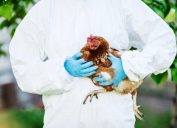Second Human Bird Flu Case Is the "Tip of the Iceberg," Pandemic Expert Says
The CDC confirmed that another dairy farm worker has been infected with bird flu.

A widespread outbreak of bird flu is infecting birds worldwide—but the virus hasn't stopped there. The current avian influenza virus, known as H5N1, has also spread to both poultry and dairy cows in the U.S., according to the Centers for Disease Control and Prevention (CDC). And while bird flu viruses don't normally infect people, the CDC just confirmed a second human case.
RELATED: CDC Issues New Alert After Human Case of Bird Flu in the U.S.—These Are the Symptoms.
In a May 22 press release, the CDC announced that a human case of the H5N1 virus had been detected in the state of Michigan. According to the agency, the infected individual is a dairy farm worker who has been working in an area where the virus had already been identified in cows.
"While a nasal swab from the person tested negative for influenza in Michigan, an eye swab from the patient was shipped to CDC and tested positive for influenza A(H5) virus, indicating an eye infection," the CDC stated.
This is the second human case associated with the ongoing multistate outbreak of H5N1 in dairy cows. The first was reported on April 1, in a dairy farm worker from Texas.
"We found this case because we were looking for this case. And we were looking for it because we were prepared. And in particular, the state of Michigan was prepared," Nirav Shah, MD, the CDC's principal deputy director said during a press conference organized by the U.S. Department of Health and Human Services (HHS), per STAT.
But some experts are concerned that the spread of this virus in humans is more widespread than we know, as other states are not looking for H5N1 cases as aggressively as Michigan is.
"If there's any takeaway from this finding it's that this is probably the tip of the iceberg because this is the one state that we know of that has done the most in terms of testing on farms of both cows and also monitoring workers that are on the farms where they found cattle infections," Jennifer Nuzzo, DrPH, director of the Pandemic Center at Brown University's School of Public Health, told STAT.
Nuzzo added, "The absence of finding cases is being interpreted as reassuring, that this [outbreak] is perhaps something that is abating. And I have absolutely no ability to tell you that's happening, in part because I think the testing that we're doing could very well be qualitatively … misleading."
RELATED: Bird Flu Detected in Grocery Store Milk—What That Means for You.
For the time being, the CDC said this newly detected case has not changed its H5N1 bird flu human health risk assessment for the general public, with the risk still considered to be low.
This is only the third ever known human case of bird flu in the U.S. The first instance was in 2022, with the virus detected in a person in Colorado who had direct exposure to poultry that was presumed to be infected with the H5N1 virus.
At the same time, the CDC has indicated that the spread of avian flu viruses from person-to-person is very rare and has never occurred in the U.S.
"However, this development underscores the importance of recommended precautions in people with exposure to infected or potentially infected animals," the agency cautioned. "People with close or prolonged, unprotected exposures to infected birds or other animals (including livestock), or to environments contaminated by infected birds or other animals, are at greater risk of infection."
Best Life offers the most up-to-date information from top experts, new research, and health agencies, but our content is not meant to be a substitute for professional guidance. When it comes to the medication you're taking or any other health questions you have, always consult your healthcare provider directly.





















